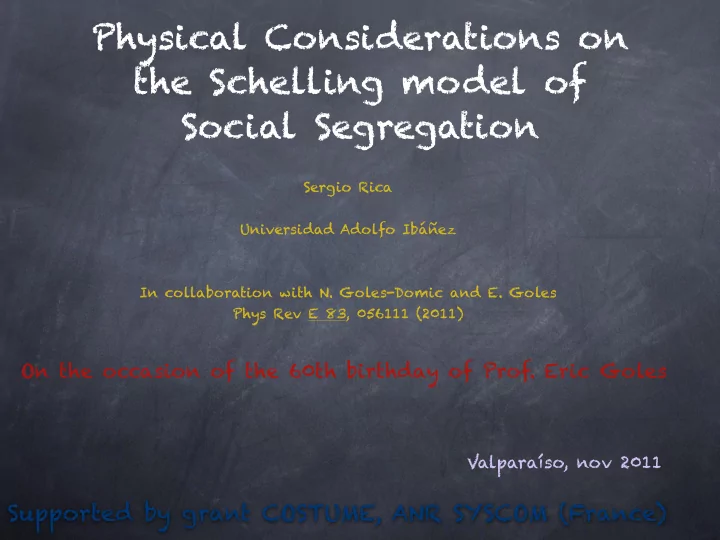

Physical Considerations on the Schelling model of Social Segregation Sergio Rica Universidad Adolfo Ibáñez In collaboration with N. Goles-Domic and E. Goles Phys Rev E 83, 056111 (2011) On the occasion of the 60th birthday of Prof. Eric Goles Valparaíso, nov 2011 Supported by grant COSTUME, ANR SYSCOM (France)
Plan Introduction The Schelling Model Qualitative behavior Quantitative behavior Discussion
The Model of Segregation by Shelling T homas C. Schelling (1969 - 1972) x k Lattice {i,k} x k State x k = ± 1 Vicinity x k Tolerance threshold
Happiness threshold An individual is unhappy if there are more than individuals of θ the other type. eg. in a vicinity of 8 neighbors and if θ = 5 then :
The rule At each step, one lists the unhappy individuals of both species, and then randomly one exchanges two individuals of opposite specie. R e m a r k : t h e n u m b e r o f individuals of each specie (N + & N - ) are conserved. � x ik = N + − N − = Cte i,k
θ = 5
Phase diagram � 50% 25% 12.5% 6 2 3 4 5 7 � finite time evolution infinite time evolution N + φ = N + + N −
Comments A tendency of segregation. A tendency of a diminution of the interfaces But! there is a strong frustration. A length scale ?
Length scale for θ = 5 512 x 512 256 x 256 128 x 128 32 x 32 64 x 64
8 neighbors Case of 44 neighbors
8 neighbors Case of 68 neighbors
Summary 8 neighbors 44 neighbors 68 neighbors
Quantitative behavior For 8 neighbors and, if θ = 5 and higher, then the “energy" N E [ { x } ] = − 1 � � x k x i 2 k =1 i ∈ V k decreases strictly during the evolution. Moreover, ∆ E kl ≤ 4 ( w kl + 8 − 2 θ ) where w kl ≤ 1
Geometrical interpretation N N E [ { x } ] = − 1 1 + 1 � � � � (1 − x k x i ) 2 2 i ∈ V k i ∈ V k k =1 k =1 N = − 1 28 N + 1 � � (1 − x k x i ) 2 i ∈ V k k =1 � � � � E = − 4 N + 2 × 3 edges − corners = − 4 N + 2 × (3 × perimeter − Nb . of corners) ,
Few Consequences Because the energy is bounded - 4 N ≤ E ≤ 4 N the dynamics is of finite time for and θ = 5 higher. For the dynamics continues θ ≤ 3 indefinitely The case may posses a θ = 4 complex dynamics The energy ground state.
Phase diagram � 50% 25% 12.5% 6 2 3 4 5 7 � finite time evolution infinite time evolution N + φ = N + + N −
E vs time 3 t [10 units ] � =2 � =6 � =3 � =5 � =4 E/N GSE
E vs time 3 t [10 units ] � =2 � =5 � =3 � =4 E/N GSE
Discussion Var i a nt s o n t h e m o d e l a n d g en eralizatio ns (g rap hs, no n uniform tolerance, various states, protocols...) Q2R Segregation in higher dimensions ?
Segregation in 3D
Recommend
More recommend